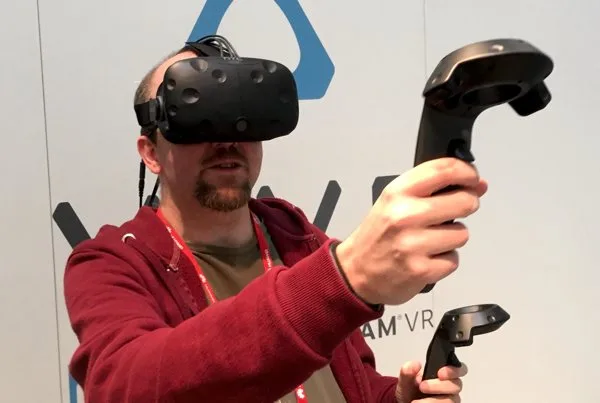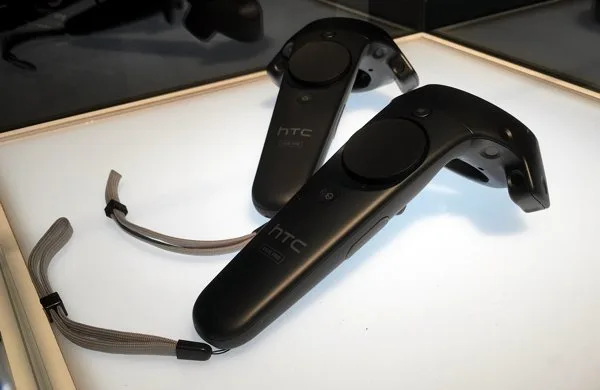HTC Vive Hands-On

HTC and Valve are hyping the HTC Valve as the must-have VR headset. We went hands-on to see what all the fuss was about.
HTC has just opened up pre-orders for the HTC Vive, its take on a virtual reality headset first announced at Mobile World Congress in 2015. The Vive uses a combination of a headset tethered to a PC along with two handheld controllers for in-game motion and headphones for delivery of audio content.
At Mobile World Congress in Barcelona recently I had the chance for a 30 minute demonstration session with the HTC Vive Pre; that’s the ever-so-slightly-preproduction version of the Vive, although it’s not expected that the primary specifications will change all that much in the final unit, which you can order now.
A heavily guided demonstration session isn’t the ideal way to peer into every nook and cranny of the Vive experience; these are only early impressions of what Vive should be capable of.

HTC Vive: Early upsides
- Very crisp visuals -- even if you wear glasses
One aspect of VR that consistently confounds me is that many headsets are built with the needs of folks with 20/20 vision in mind, so if you wear glasses, you often struggle with focus and comfortable positioning. Dropping the HTC Vive Pre over my head, I had none of those issues, with clear focus and a comfortable wearing experience throughout. - Clever positioning system
The Vive itself needs to be tethered to a reasonably high-end PC -- you can compare its necessary specifications against the Oculus Rift and Playstation VR here -- but it’s a full immersion experience. So how do you stop yourself bumping into walls? By drawing them out beforehand in the Vive application, at which point whatever you’re doing in-game will track to those co-ordinates, giving you a simple holographic style warning when you’re veering too close. There’s still no warning system for pets that might stray into view, but you can quickly and easily switch to a near real world view called Chaperone that gives you outlines of nearby objects displayed if this concerns you. - HTC and Valve might have the games edge
There’s going to be no shortage of competition in the VR space this year, with the Oculus Rift and Playstation VR both set to launch, and both with a fairly strong focus on games-style entertainment. The demonstrations that HTC ran through showed Valve’s typical attention to detail, as well as a touch of dry wit. Oculus has something of a developer headstart in this space and Sony’s clearly got form in the general games arena, but what HTC had to show off, even now, was very impressive. - The best experiences might not be games
HTC ran me through a few simple demonstrations that largely served as tutorials for the full HTC Vive experience, covering moving, using controllers and the like. Most of those experience took the form of games, save for a Google owned art experience which was, if anything, the best thing going. Not that I have particular artistic flair, but it’s genuinely surprising how attached you get to virtual paintstrokes hanging in the air in front of you. For every other experience while the immersion was good, I was keenly aware of how artificial the environment was. Having painted a decent approximation of an ’80s music video neon swirl, I wasn’t happy for some reason to step through it, though clearly I could have. That points to immersion possibilities well beyond simple gaming.

HTC Vive: Early downsides
- It’s going to be expensive
Outright, the HTC Vive is going to cost USD$799. However, that’s not the only pricing consideration to take into account, because it also requires a relatively high-end PC running an Intel i5-4590, AMD FX 8350 equivalent or better with an Nvidia GeForce GTX 970 or AMD Radeon R9 290 graphics processor or better. For most of us, that would be an additional purchase on top of that. VR will tumble in price over time, and there are cheaper alternatives, such as the Samsung Gear VR (if you’ve already got a compatible Samsung Galaxy phone), but that experience isn’t anywhere near the complexity of the HTC Vive’s possibilities. The same is largely true for the slightly cheaper Oculus Rift, with the Playstation VR likely to be the lowest overall cost possibility, simply due to the lower cost of Playstation 4 consoles. - Controller learning curve
The HTC Vive’s controllers are odd devices, somewhat reminiscent of the Wii’s remotes in execution but with more buttons and toggles. Within the Vive environment they’re represented virtually, so you can see where your hands are holding them -- but you can’t see your actual hands. Why would that matter? Largely because there’s a definite learning curve to working out where your fingers are to adjust controls, especially the selection dial pad at the top of each controller. Quite a few times I went to tap on something but clearly moved a finger above or below where I wanted to actually be. - You will still need clear space
The way the HTC Vive deals with limited space is clever, but it’s not foolproof, and to make the most of the experience you’ve got to have enough space to clearly use it. You’ve also got to be careful with the tethered link to the PC; this wouldn’t be as much of an issue if you’ve got someone nearby ensuring you don’t trip over it, but if you VR game alone, it wouldn’t take much to end up tripping over an unseen obstacle, even with the clever see-through Chaperone mode. - It's early days in consumer VR
Making an investment in the HTC Vive -- or Oculus Rift, or Playstation VR, or even holding out for the Microsoft Hololens -- won't be a small affair, but it's by no means clear to see at this point whether there will be a dominant format. Jumping in as an early adopter does give you early access, but you're also gambling as to the long term viability of the Vive versus its competition -- or even devices yet to come.
